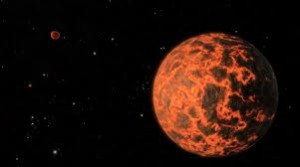 According to a statement from NASA, a team of astronomers have found what appears to be a planet, outside of our solar system, only about two-thirds the size of Earth. The recent discovery was made using NASA’s Spitzer Space Telescope.
According to a statement from NASA, a team of astronomers have found what appears to be a planet, outside of our solar system, only about two-thirds the size of Earth. The recent discovery was made using NASA’s Spitzer Space Telescope.
Labeled UCF-1.01, the small exoplanet is about 33 light-years away, not a very large distance on the scale of the universe and other recent exoplanetary discoveries. In fact, UFC 1.01 is, so far, the closest exoplanet to our own system of planets smaller than the Earth.
“We have found strong evidence for a very small, very hot and very near planet with the help of the Spitzer Space Telescope,” said Kevin Stevenson from the University of Central Florida in Orlando. Stevenson is lead author of the paper, which has been accepted for publication in The Astrophysical Journal. “Identifying nearby small planets such as UCF-1.01 may one day lead to their characterization using future instruments.”
According to NASA, the discovery was a surprise to Stevenson and his team. The group was studying a Neptune-sized exoplanet GJ 436b, which orbits around the red-dwarf star GJ 436. During their research, the team of astronomers noticed slight dips in the amount of infrared light streaming from the star, separate from the dips caused by GJ 436b. Further analysis of the data showed the dips were periodic, suggesting a second planet might be blocking out a small fraction of the star’s light.
Using well established techniques which measure changes in the intensity and other properties of the light blocked by the planet, the team was able to determine the approximate size of the planet and its distance from Earth. The team also determined that the orbital period of UCF-1.01 around GJ 436 is very short. One year on UCF-1.01 would take only about 1.4 Earth days.
Chances of life on the newly discovered exoplanet are slim however. The planet is very close in its orbit around its parent star. At only about 7 times the distance from the Earth to the Moon away from the heat of GJ 436, UCF-1.01 surface temperature would be in excess of 1,000 degrees Fahrenheit.
“I hope future observations will confirm these exciting results, which show Spitzer may be able to discover exoplanets as small as Mars,” said Michael Werner, Spitzer Project Scientist at NASA’s Jet Propulsion Laboratory (JPL) in Pasadena, Calif. “Even after almost nine years in space, Spitzer’s observations continue to take us in new and important scientific directions.”
![Herbal Reference Substances are Key to Everyday Products <!-- AddThis Sharing Buttons above -->
<div class="addthis_toolbox addthis_default_style " addthis:url='http://newstaar.com/herbal-reference-substances-are-key-to-everyday-products/3512112/' >
<a class="addthis_button_facebook_like" fb:like:layout="button_count"></a>
<a class="addthis_button_tweet"></a>
<a class="addthis_button_pinterest_pinit"></a>
<a class="addthis_counter addthis_pill_style"></a>
</div>When it comes to quality control testing and the development of new products, Botanical Reference Materials (BRMs), also known as Herbal References are critically important. To help companies ultimately obtain all-important FDA approval, the Food and Drug Administration provides in its guidance a recommendation that […]<!-- AddThis Sharing Buttons below -->
<div class="addthis_toolbox addthis_default_style addthis_32x32_style" addthis:url='http://newstaar.com/herbal-reference-substances-are-key-to-everyday-products/3512112/' >
<a class="addthis_button_preferred_1"></a>
<a class="addthis_button_preferred_2"></a>
<a class="addthis_button_preferred_3"></a>
<a class="addthis_button_preferred_4"></a>
<a class="addthis_button_compact"></a>
<a class="addthis_counter addthis_bubble_style"></a>
</div>](http://newstaar.com/wp-content/uploads/2021/02/Achillea_millefolium_flowers-100x100.jpg)
![Quality Electrochemical Biosensors are Critical for Medical, Food and Chemical Industry <!-- AddThis Sharing Buttons above -->
<div class="addthis_toolbox addthis_default_style " addthis:url='http://newstaar.com/quality-electrochemical-biosensors-are-critical-for-medical-food-and-chemical-industry/3512086/' >
<a class="addthis_button_facebook_like" fb:like:layout="button_count"></a>
<a class="addthis_button_tweet"></a>
<a class="addthis_button_pinterest_pinit"></a>
<a class="addthis_counter addthis_pill_style"></a>
</div>A number of industries have, at their core, a need to frequent or even continuous analysis of biological media. These include the medical and pharmaceutical fields, biotech firms, and food and chemical companies. To maintain quality standards and develop new products, these industries rely heavily […]<!-- AddThis Sharing Buttons below -->
<div class="addthis_toolbox addthis_default_style addthis_32x32_style" addthis:url='http://newstaar.com/quality-electrochemical-biosensors-are-critical-for-medical-food-and-chemical-industry/3512086/' >
<a class="addthis_button_preferred_1"></a>
<a class="addthis_button_preferred_2"></a>
<a class="addthis_button_preferred_3"></a>
<a class="addthis_button_preferred_4"></a>
<a class="addthis_button_compact"></a>
<a class="addthis_counter addthis_bubble_style"></a>
</div>](http://newstaar.com/wp-content/uploads/2020/10/Electrochemical-Biosensor-100x100.jpg)
![Company Develops Industrial Mixers Well-Suited for both Fragile and Explosive Products <!-- AddThis Sharing Buttons above -->
<div class="addthis_toolbox addthis_default_style " addthis:url='http://newstaar.com/company-develops-industrial-mixers-well-suited-for-both-fragile-and-explosive-products/3512071/' >
<a class="addthis_button_facebook_like" fb:like:layout="button_count"></a>
<a class="addthis_button_tweet"></a>
<a class="addthis_button_pinterest_pinit"></a>
<a class="addthis_counter addthis_pill_style"></a>
</div>Industrial drum mixers are normally applied to blend mixes of varying viscosities such as adhesive slurries or cement. Some of these mixers have the capability of blending mixes of very different particle sizes such as fruit and ice cream, and gravel and cement slurry. The […]<!-- AddThis Sharing Buttons below -->
<div class="addthis_toolbox addthis_default_style addthis_32x32_style" addthis:url='http://newstaar.com/company-develops-industrial-mixers-well-suited-for-both-fragile-and-explosive-products/3512071/' >
<a class="addthis_button_preferred_1"></a>
<a class="addthis_button_preferred_2"></a>
<a class="addthis_button_preferred_3"></a>
<a class="addthis_button_preferred_4"></a>
<a class="addthis_button_compact"></a>
<a class="addthis_counter addthis_bubble_style"></a>
</div>](http://newstaar.com/wp-content/uploads/2020/06/bandeau-sofragir2-100x100.jpg)